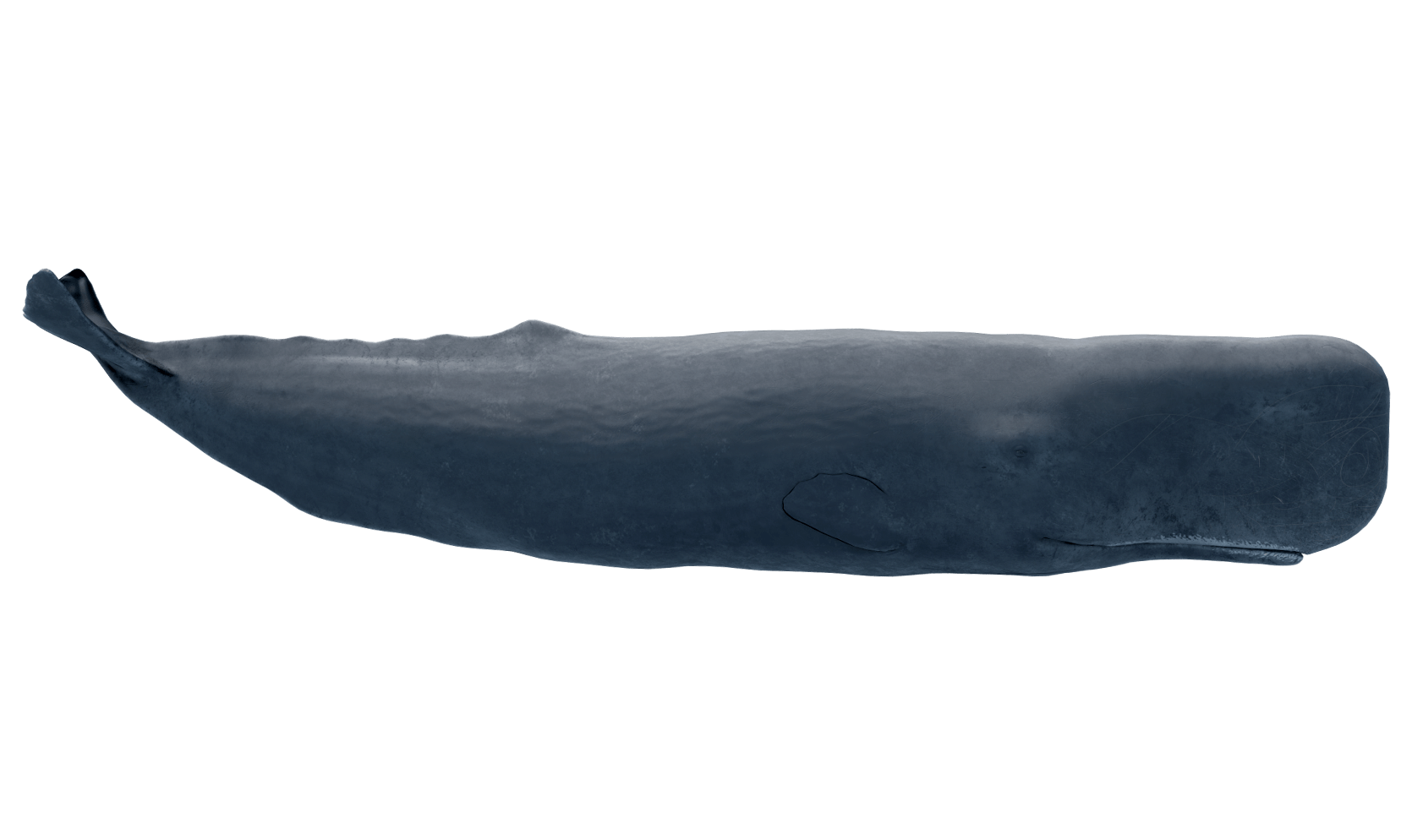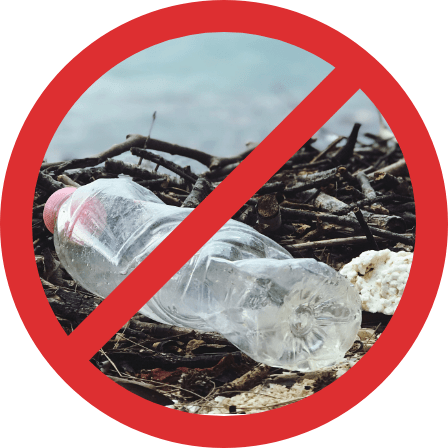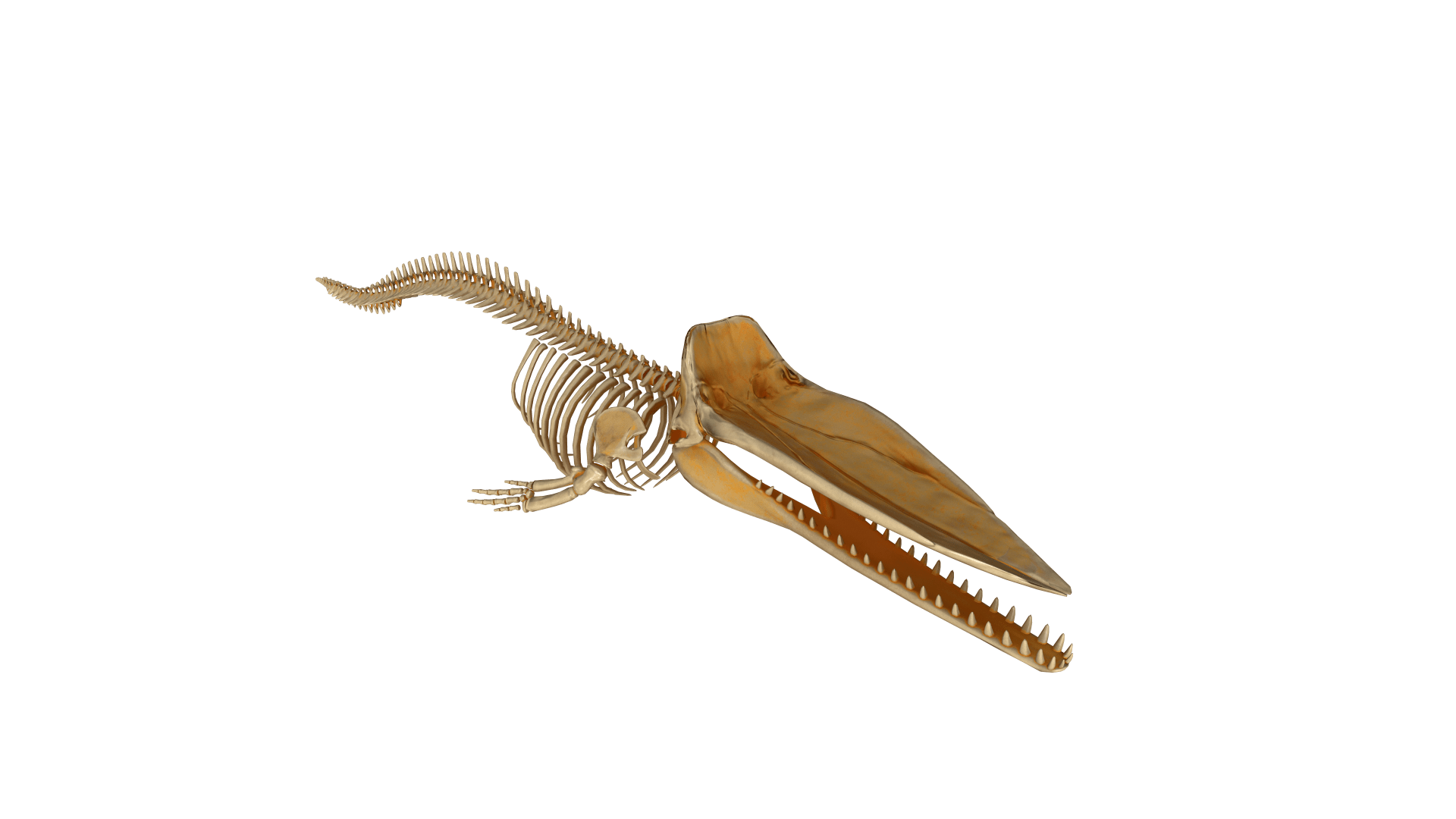Recognizable by their massive squarish head, sperm whales are the largest of all toothed whales.
About thirty different sperm whales have been identified in the St. Lawrence, but researchers did not know Valleau before he died.
Sperm whales are usually distinguished from one another by variations in the shape of their tails, which can be seen when they dive.

Credits: GREMM
A group of six sperm whales surface in the St. Lawrence Estuary. Sperm whales were more common in this region in the early 2000s. Today, most reports are isolated sightings of a single animal.
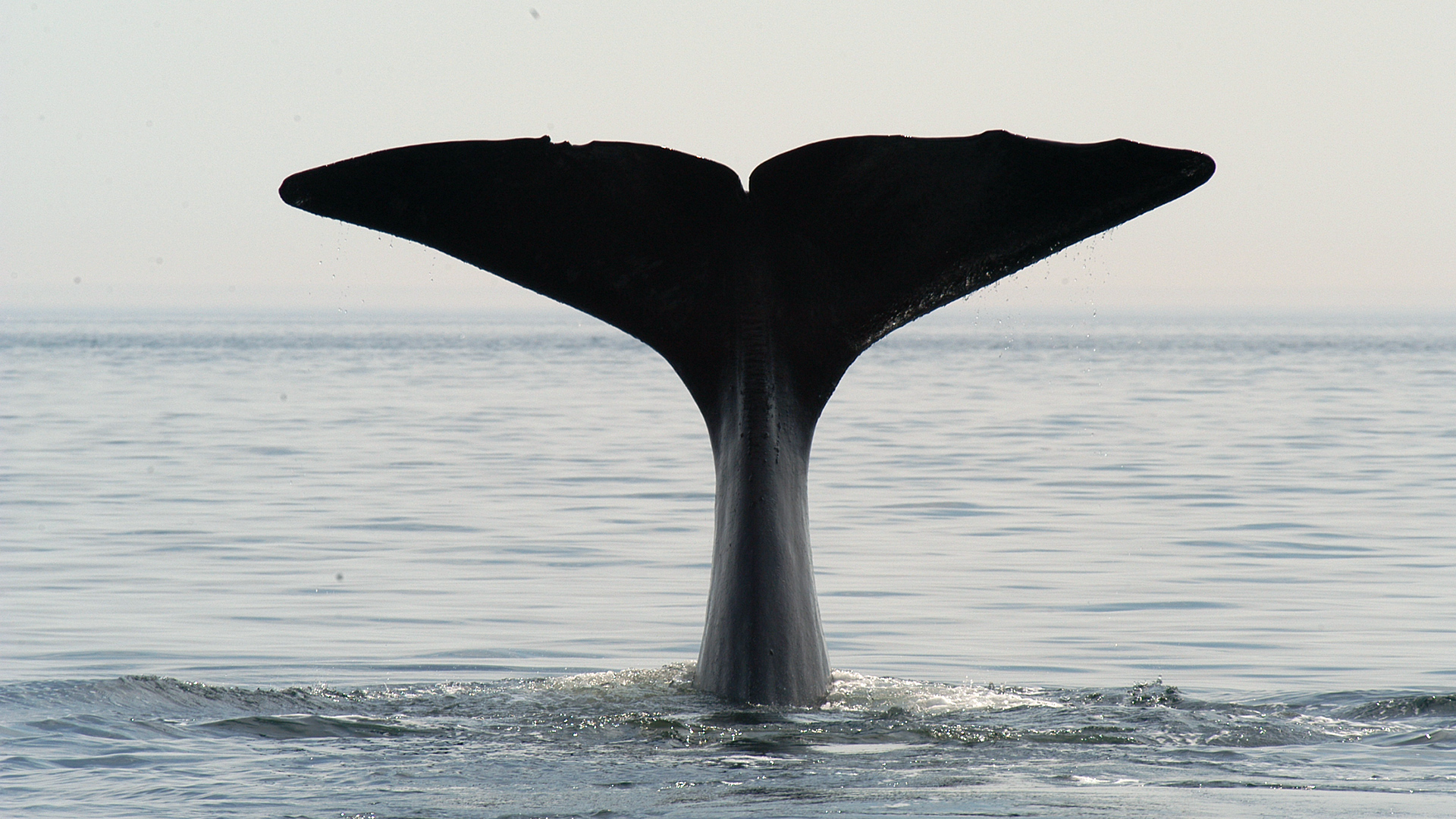
Credits: GREMM
The sperm whale Tryphon was a well known visitor to the St. Lawrence Estuary in the early 2000s until an entanglement led to his death in 2009.

On September 10, 2003, the citizens of L’Anse-à-Valleau made a surprising discovery: a sperm whale carcass had washed onto the shore. GREMM’s team travels to the Gaspé Peninsula
and begins working on flensing operations with the goal of recovering the skeleton. This is a difficult task, as the skin of the sperm whale is quite tough! Though Valleau did not appear to be in excellent health, it was not possible to determine the cause of mortality with certainty.
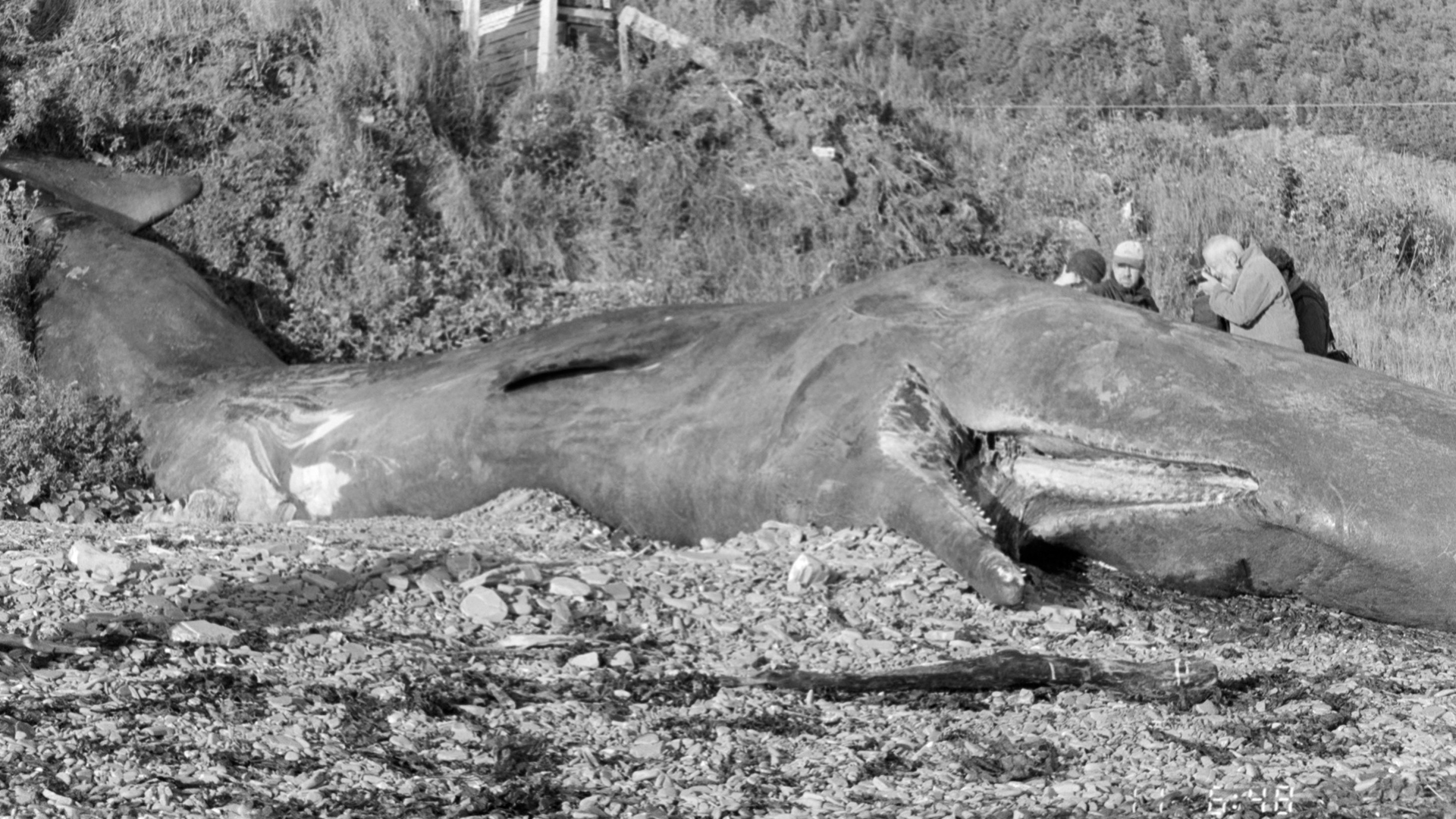
Credits: GREMM
A sperm whale carcass is quite a surprising find, as they are rare in the St. Lawrence.

Credits: Jean-Pierre Sylvestre
The sperm whale’s skin is tough. Carving up Valleau’s carcass required hours of work.
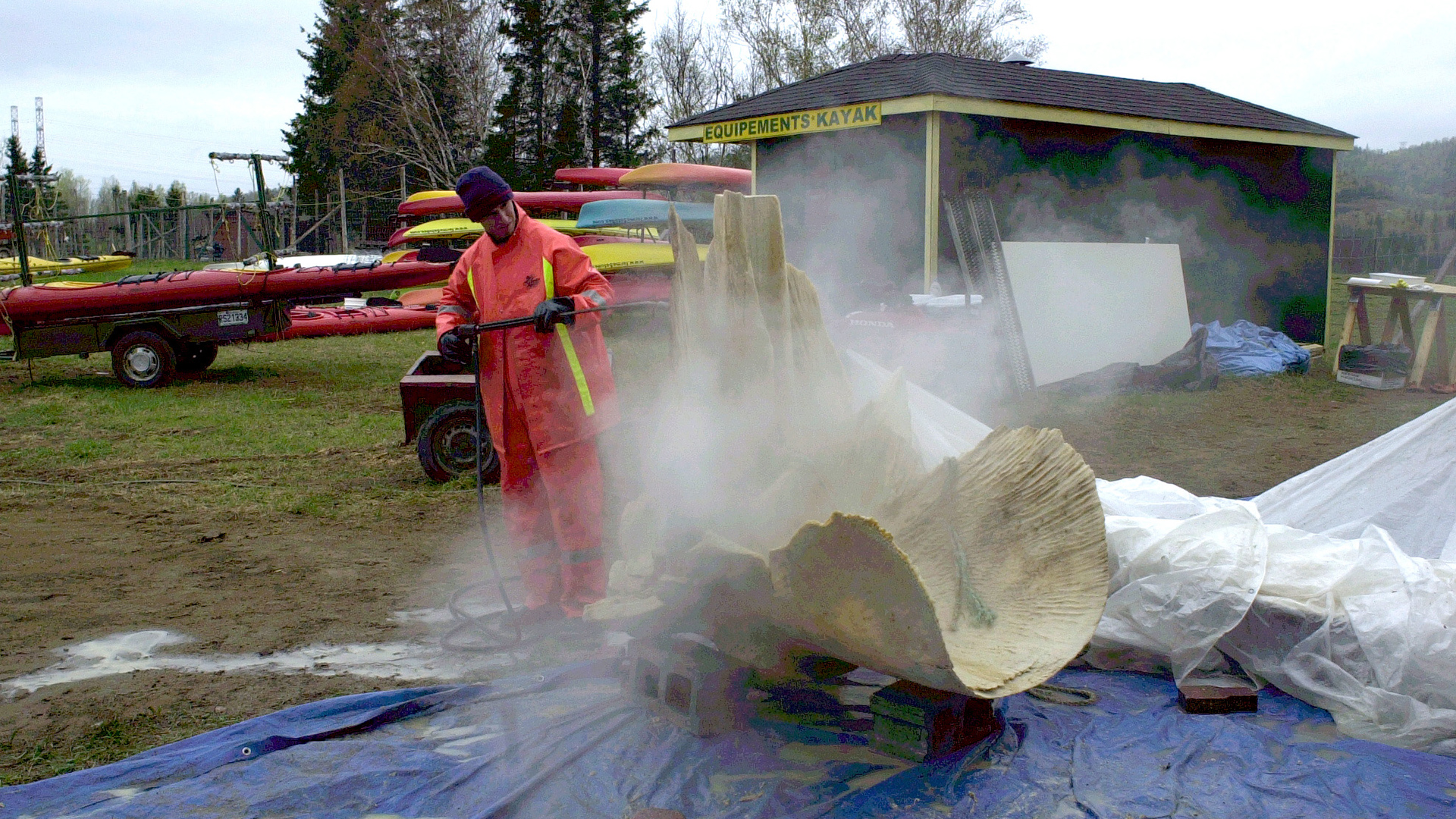
Credits: GREMM
When preparing a skeleton for an exhibition, the bones must be properly cleaned.
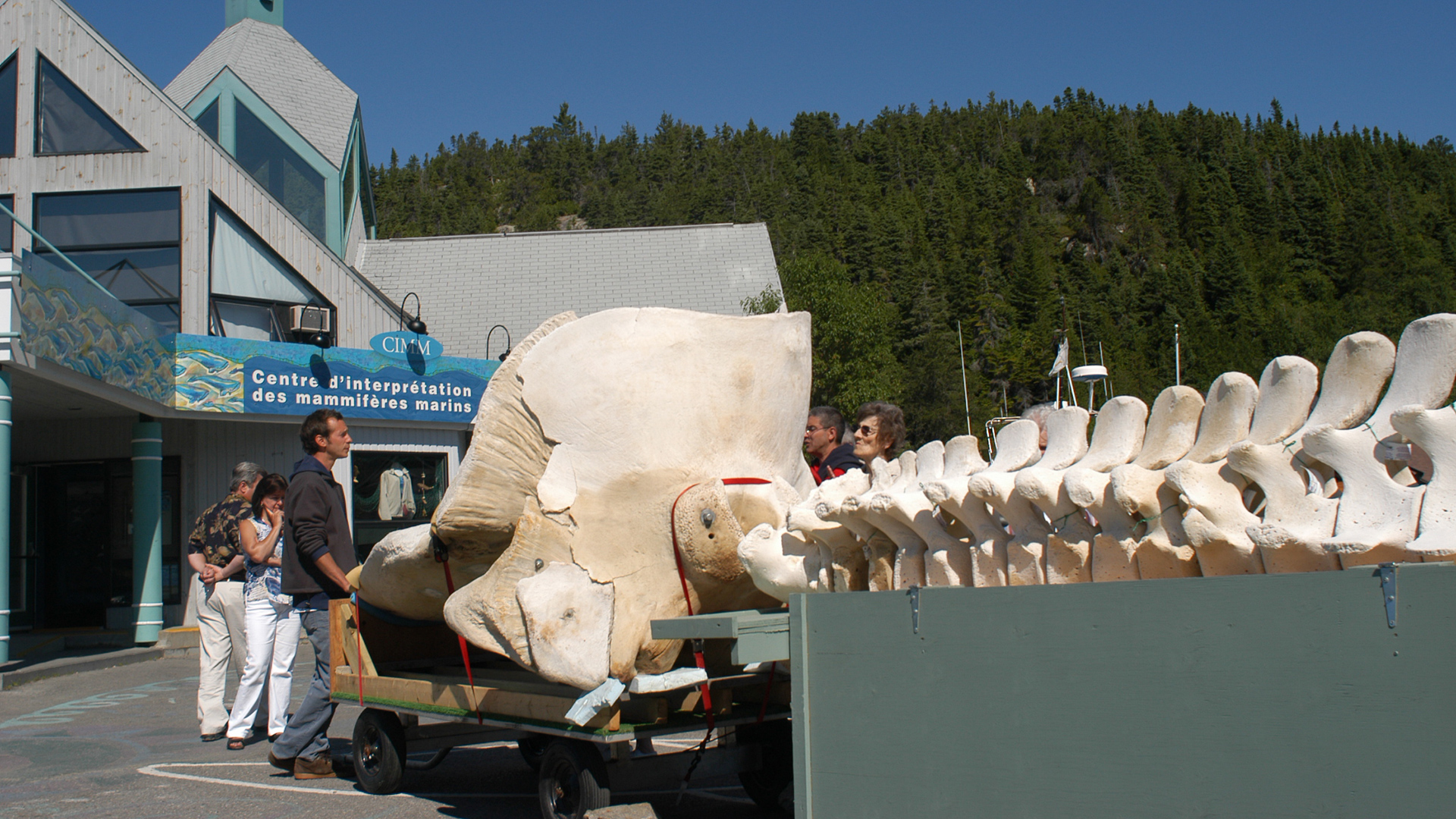
Credits: GREMM
Valleau’s skeleton spent a few years outside before being incorporated into the museum’s indoor collection in 2009.

Valleau had large circles on his skin. Could they be scars left by the suction cups of a giant squid, which the sperm whale sometimes feeds on?
In order to crack this mystery, a piece of skin is taken for analysis by a specialist in the matter. However, the answer appears on its own a few days later... The person who took the skin sample breaks out in small pimples; she caught whale pox!
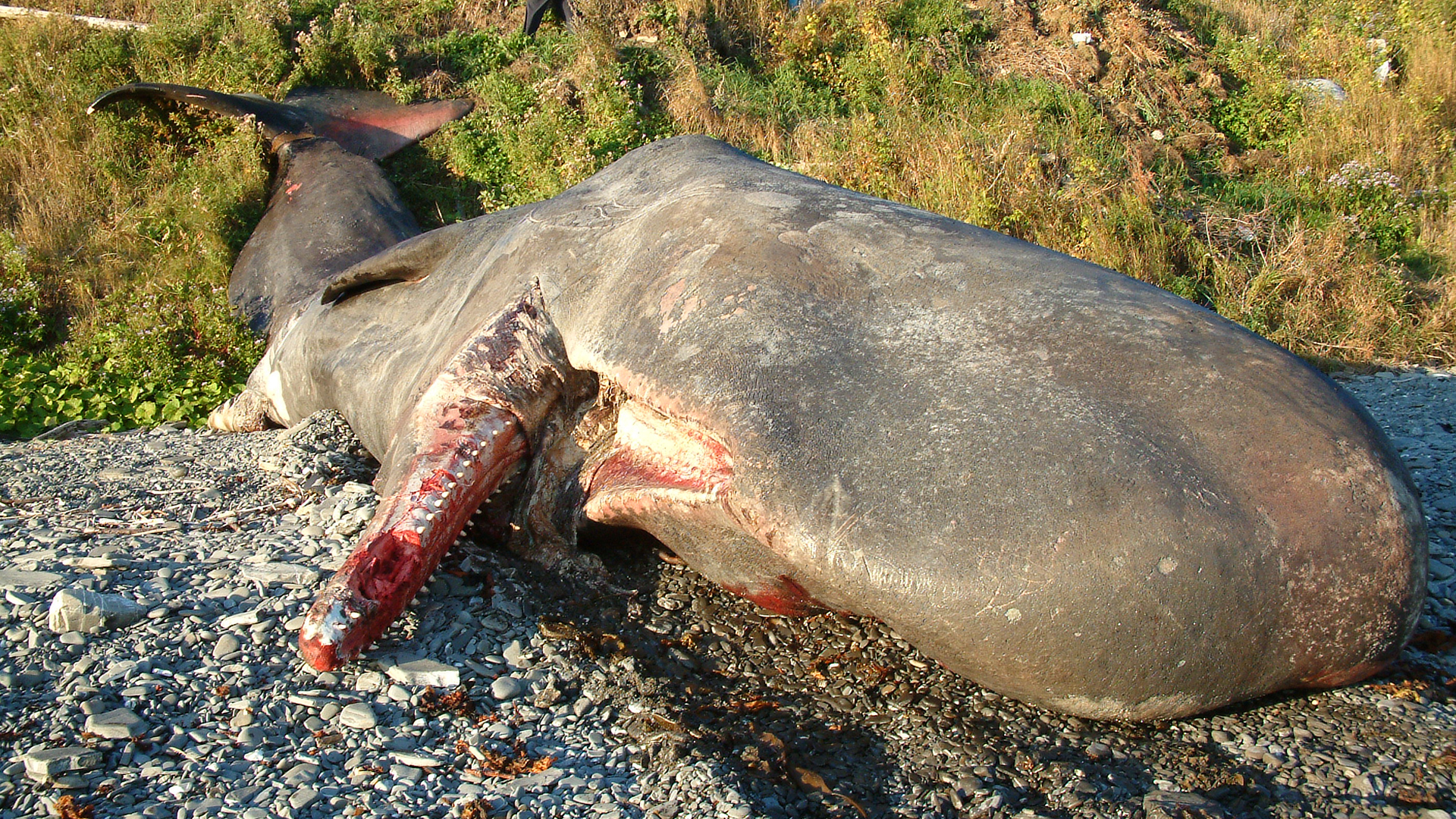
Credits: Jean-Pierre Sylvestre
Upon closer inspection, one can see paler circular markings on the side of the sperm whale’s head.

When you look at the skeleton of a sperm whale, you might wonder where its big boxy head has gone... That’s because it’s not made of bones! Rather, it is filled with soft tissues and oil, which form what is called the spermaceti organ and the melon.
As with dolphins or belugas, the melon plays a role in sound production. But this disproportionate sound box allows the sperm whale to produce the most powerful sounds in the entire animal kingdom: up to 235 decibels, which is louder than a plane taking off!
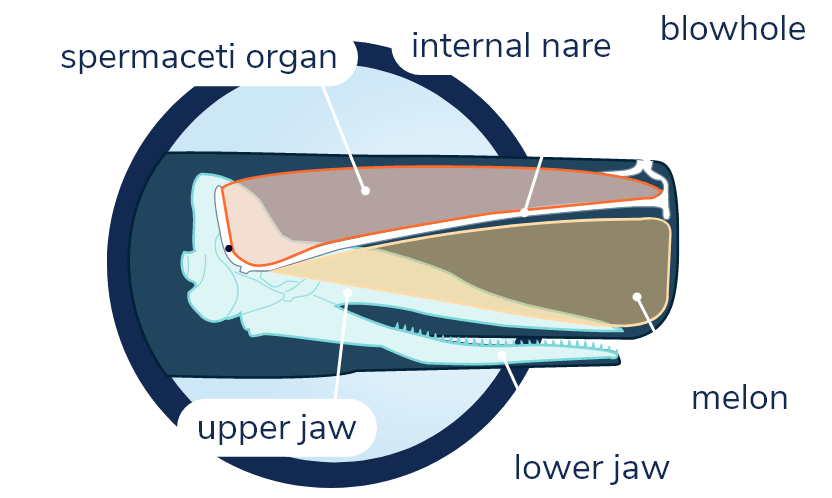

Valleau died at the young age of 25. How did we determine his age? The growth layers on one of his teeth were counted, just as one might tally the growth rings on a tree.
The tooth was sent to the Fisheries and Oceans Canada’s Maurice Lamontagne Institute, where it was cut in half lengthwise using a diamond-bladed saw.

Cross-section of one of Valleau’s teeth. The expert who analyzed the tooth counted 25 growth layers.

Not all whales eat the same thing, but they are all carnivorous.
Some are very specialized in their diet such as the blue whale, which feeds exclusively on krill. St. Lawrence belugas on the other hand are what we call generalists, meaning they have a rather varied menu. Sperm whales are not as specialized as blue whales. Though their main prey is squid, they also feed on fish and crustaceans on occasion.


How does digestion take place in whales?
Since whales swallow their food whole, they need an efficient stomach. Whales’ stomachs are similar to those of ruminants in that they are divided into different chambers, each of which has its own function.
In the first chamber, the rumen, a mechanical-type digestion takes place. The walls of the rumen are thick and muscular to crush the food, since whales do not chew.
This is very useful for sperm whales, since it allows them to withstand attacks from the beaks and suction cups of squid angry at having been swallowed. The food then passes into the main stomach chamber, where chemical digestion begins with enzymes. This process continues in the pylorus, where the contents become covered with mucus to facilitate their passage through the intestine.
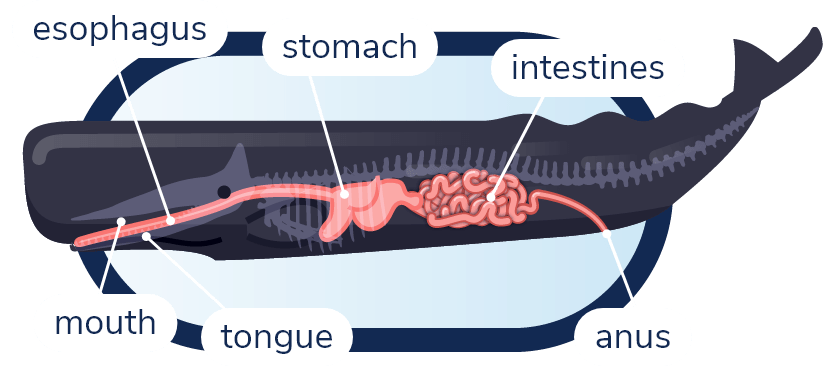

What does whale poo look like?
Whales usually defecate near the surface, far from depth pressure. The color of the feces can give us a clue about the whale's menu.
Reddish poo could indicate a diet rich in krill, while greener poo could be a sign that the whale fed mainly on fish.
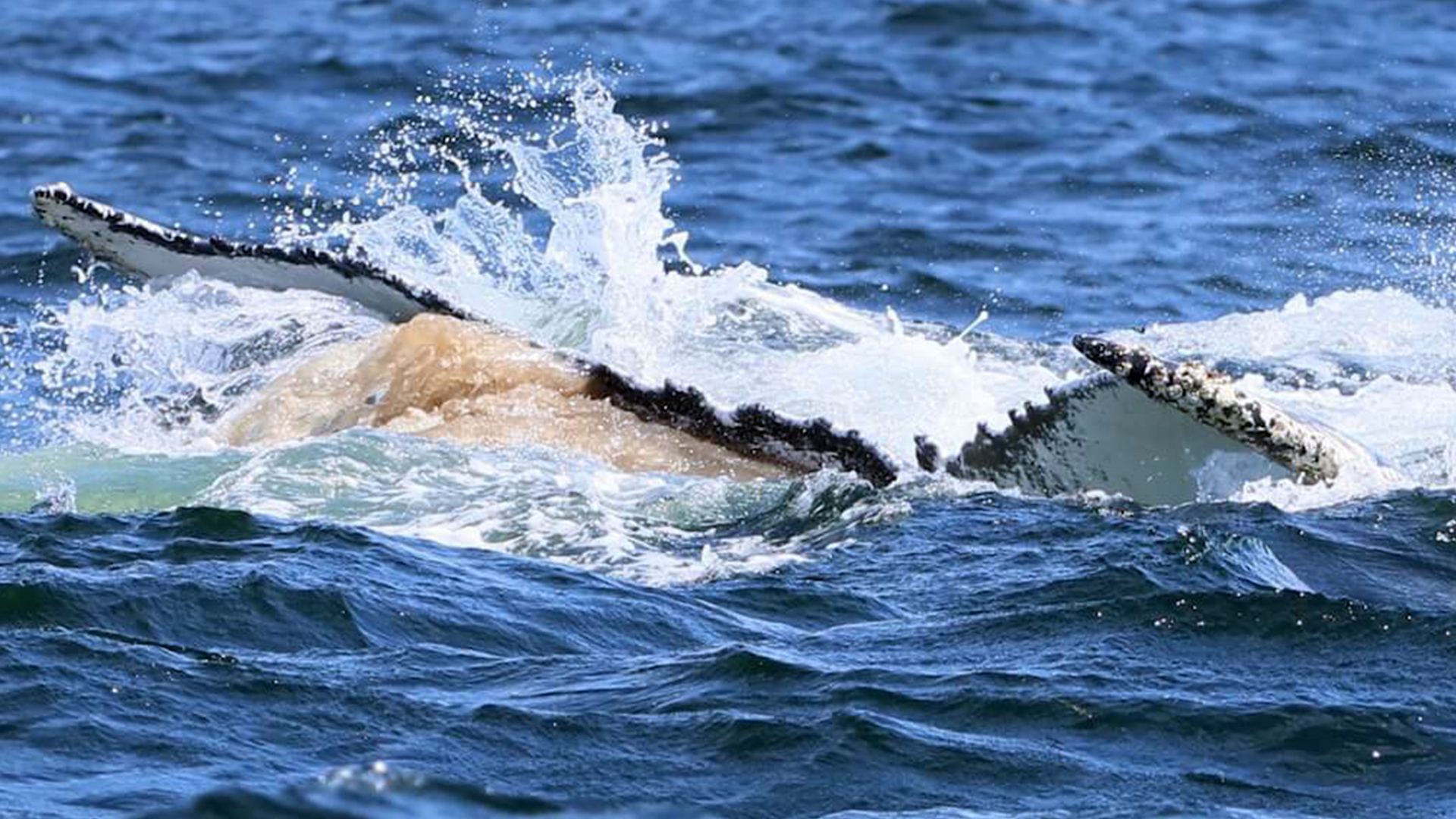
Credits: René Roy
This humpback whale’s feces is rather reddish in colour, indicating that the animal has fed mainly on krill.

How is whale poo helping to fight climate change?
The fact that whales release their excrement at the surface is good for phytoplankton, which benefit from the free fertilizer! These microscopic, CO2-breathing algae at the base of the ocean’s food chain only grow on the surface where there is light.
What’s the connection with climate change? Carbon dioxide is one of the main gases responsible for the greenhouse effect and global warming! In order to grow, algae need CO2, and the more they grow, the greater the amounts of this gas they capture from the atmosphere.
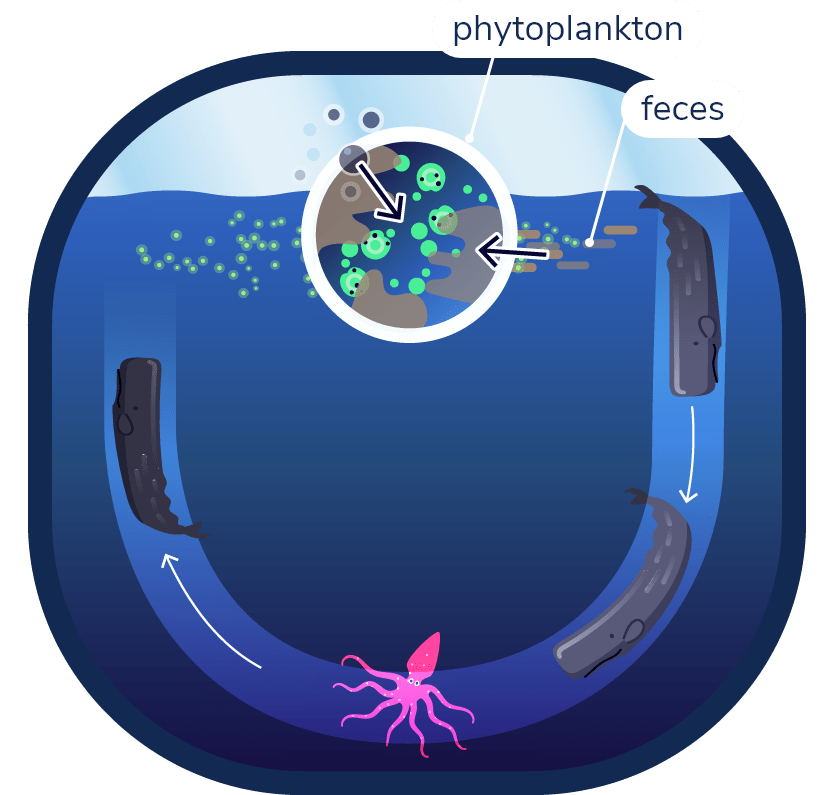

What is ambergris?
When a sperm whale captures a squid, it swallows it whole, including the beak. Most often, it vomits the beak because the latter cannot be digested... But, should a beak make its way into the intestine, the sperm whale’s digestive system secretes a substance that makes the sharp-tipped beak easier to pass. This substance is called ambergris.

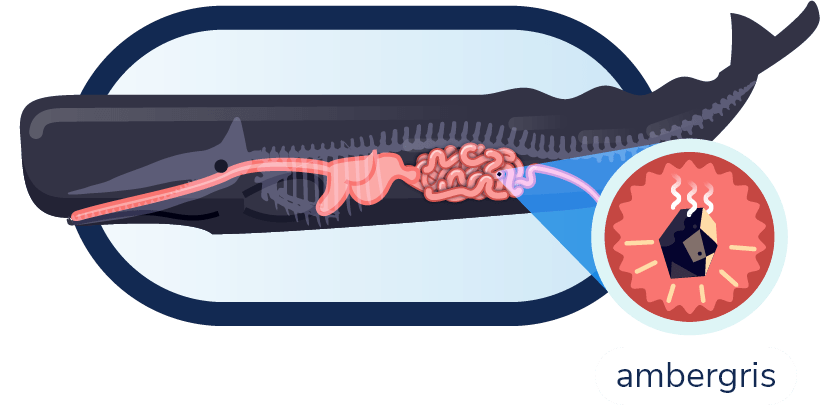
What is ambergris?
When a sperm whale captures a squid, it swallows it whole, including the beak. Most often, it vomits the beak because the latter cannot be digested... But, should a beak make its way into the intestine, the sperm whale’s digestive system secretes a substance that makes the sharp-tipped beak easier to pass. This substance is called ambergris.
What you need to know is that ambergris is worth more than its weight in gold! How can whale “poo” be so expensive? Ambergris has the ability to retain odours for a very long time, a highly sought-after property in the perfume industry!


A lot of trash accumulates in our oceans and waterways. Plastic bags and containers, nets, ropes... This anthropogenic refuse can take hundreds of years to break down.
And if waste ends up in whale habitat, it is not necessarily because it was directly dumped there. For example, it may have been carried by the wind or found its way there through the sewer networks. Then, once it reaches the water, some waste can be carried hundreds or even thousands of kilometres.

Credits: Blue Organization
Garbage washed up on the St. Lawrence shoreline in Sainte-Marthe-sur-le-Lac in Quebec.

Trash can be ingested by whales, either because they mistake it for prey or simply because it was in their jaws’ path.
When Valleau's carcass was discovered, its entire gastrointestinal tract was inspected (in the event any ambergris was present). Indeed, something was found there... Unfortunately, it was not ambergris, but rather a heap of waste: netting, rope, plastic bag, etc.

Credits: Jean-Pierre Sylvestre
Valleau’s digestive tract is being flensed, while a heap of waste is removed.

The clump of trash found in Valleau’s body was not enough to have blocked his digestive system and directly caused his death, but it might have had an effect on his state of health?
Was it making his digestion uncomfortable and/or interfering with his diet? If an animal ingests plastic instead of its usual diet, it will not receive the nutrients that this diet would usually provide.

Credits: GREMM
The hunk of waste found in Valleau’s digestive tract was cleaned and preserved.

What can we do to reduce the amount of garbage in our rivers and oceans?
Pick up waste already present.
More and more initiatives are being organized locally to dispose of the garbage that ends up on our shorelines.
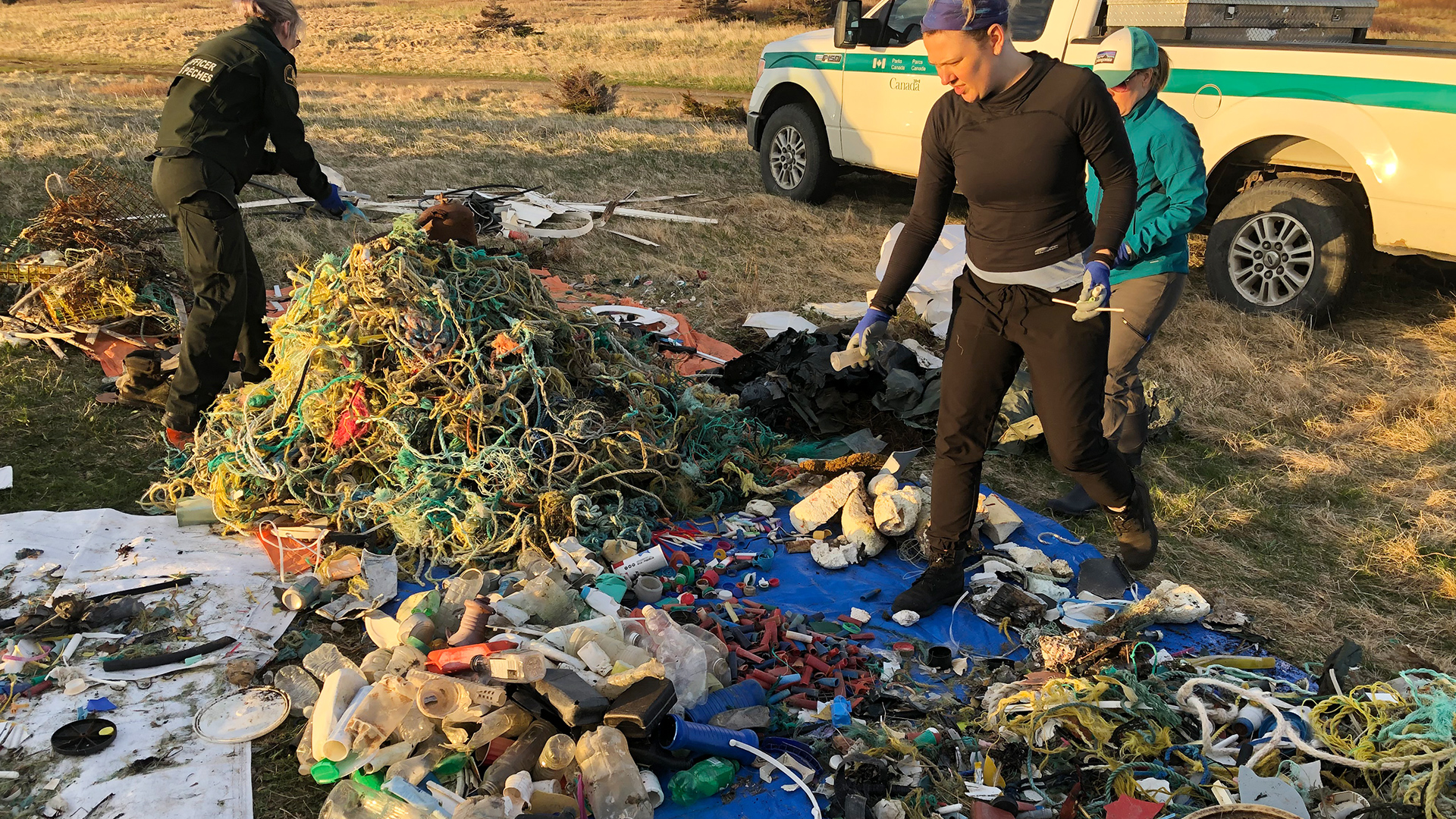
Credits: Blue Organization
Clean-up of the Atlantic shoreline in Gros Morne, Newfoundland

What can I do to reduce the amount of waste in our rivers and oceans?
Paying attention to our own consumption and where we dispose of our waste is a first step. Reusable objects should be favoured and, if they cannot be reused, recycle as much as possible.
If it can’t be recycled, be sure to properly dispose of your garbage. You can also get involved by participating in shoreline clean-up activities or simply by picking up litter that you find outdoors.



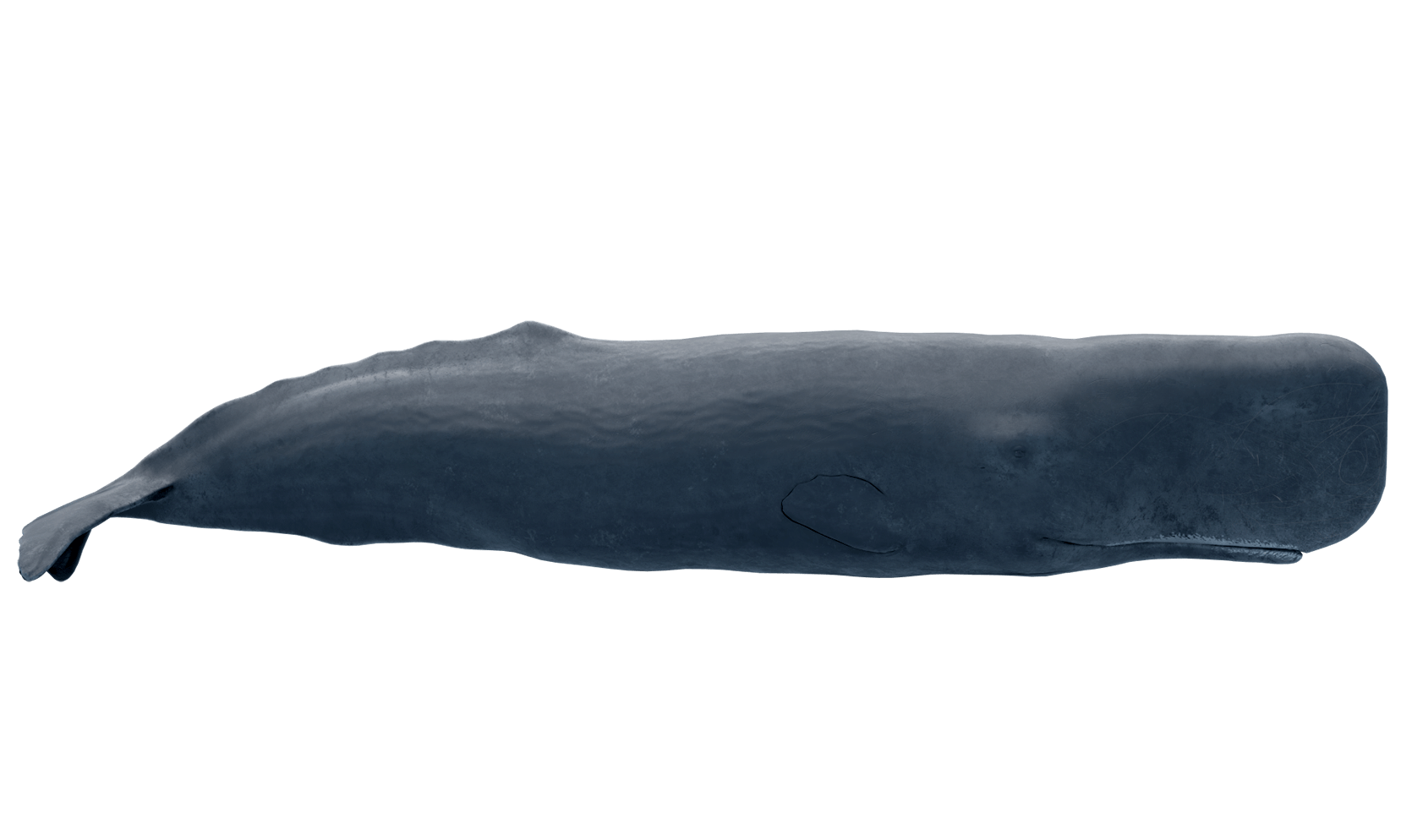
Now that you’ve heard Valleau’s story, let’s go meet the other whales!
Sperm Whale
Physeter macrocephalus
Characteristics
Sperm whales of the Northwest Atlantic

Weight
30 to 70 tons

Length
11 to 15 m, up to 18 m

Lifespan
50 to 70 years

Population
approximately 4,700 individuals

Status
Not at risk
Valleau

Weight
approx. 30 tonnes

Length
13 m

Birth - Death
1978 - September 2003

ID number
not known to researchers

Sex
Male

Valleau’s skeleton has been on display at the Marine Mammals Interpretation Centre in Tadoussac since 2009. For a long time, it was the largest specimen in the exhibition, before being eclipsed by a right whale and a fin whale in 2020.

Sperm Whale
Physeter macrocephalus
Characteristics
Sperm whales of the Northwest Atlantic

Weight
30 to 70 tons

Length
11 to 15 m, up to 18 m

Lifespan
50 to 70 years

Population
approximately 4,700 individuals

Status
Not at risk
Valleau

Weight
approx. 30 tonnes

Length
13 m

Birth - Death
1978 - September 2003

ID number
not known to researchers

Sex
Male

Valleau’s skeleton has been on display at the Marine Mammals Interpretation Centre in Tadoussac since 2009. For a long time, it was the largest specimen in the exhibition, before being eclipsed by a right whale and a fin whale in 2020.

